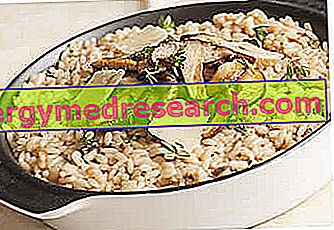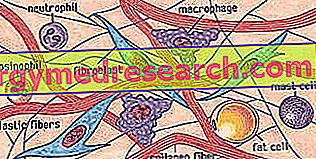WARNING! In the mycological field it is good to take into consideration the risk of intoxication and poisoning; for this reason, in the absence of an appropriate training protocol, it is advisable to obtain supplies only from reliable commercial sources.
Generality
Risotto with mushrooms is a typical Italian first course which generally takes on the role of an autumn recipe.

Risotto with mushrooms is not a very caloric food. It lends itself to many diets, such as those of clinical nutrition. In this case, both the portions and the preparation methodology play an essential role, to say the least, in the relevance or otherwise of the recipe in the diet.
The various formulas of mushroom risotto are as many as the combinations between the variety of ingredients and the personalization of those who cook it. Below are some very useful notions to better understand the variables to be managed in the production of a good dish.
Nutritional Features
Even before delving into the description of the main ingredients of a good mushroom risotto, we cite the nutritional characteristics of a (so to speak) "medium recipe".
The portions of the mushroom risotto that we will analyze are calculated for 4 people:
- 300g of white rice with short grain,
- about 600ml of broth,
- 400g of fresh mushrooms (100g porcini mushrooms, 100g nails, 100g cockerels, 100g champignons),
- half a glass of wine (not considered in the translation),
- a sprig of parsley,
- 2 tablespoons of oil
- 2 tablespoons of finely grated Parmesan cheese.
First of all, we specify that the nutritional values refer to the cooked food, not to the raw ingredients. This implies a significant reduction in nutritional density which, at dry (without the broth), should be at least twice as much as suggested.
However, keep in mind that a ladle of risotto corresponds to about 200g of food, obviously a variable amount depending on the operator's manual skills and the instrument used.
Risotto with mushrooms is a rather low energy dish, mainly supplied by complex carbohydrates (starch). The proteins, basically of medium biological value, are quite scarce; the same applies to lipids, of which the triglycerides appear to be composed mainly of monounsaturated fatty acids.
Cholesterol is very low, while the fiber is not negligible.
From a vitamin point of view, the mushroom risotto does not strain. Those present in the most important measure are from group B and, among all, niacin seems to be more relevant. The fat-soluble vitamins do not reach concentrations worthy of note, as does C (which is also highly thermolabile).
As far as mineral salts are concerned, the only one that deserves to be mentioned is iron, although it should be present in a poorly bioavailable form. We recall that the concentration of sodium, apparently limited, is influenced above all by the discretionary addition of table salt; this, which if in excess can aggravate primary arterial hypertension, was not deliberately counted among the ingredients of the recipe.
Nutritional Values Mushroom Risotto | |||||||||||||||||||||||||||||||||||||||||||||||||||||||||||||||||||||||||||||||||||||||||||||||||||||||||||||||||||||||||||||||||||||||||||||||||
 | |||||||||||||||||||||||||||||||||||||||||||||||||||||||||||||||||||||||||||||||||||||||||||||||||||||||||||||||||||||||||||||||||||||||||||||||||
| |||||||||||||||||||||||||||||||||||||||||||||||||||||||||||||||||||||||||||||||||||||||||||||||||||||||||||||||||||||||||||||||||||||||||||||||||
Risotto with mushrooms is a food that does not present major nutritional contraindications, on the contrary. However, it is necessary to remember that some "pathologies of the replacement" can negatively suffer the excess of carbohydrates in the diet (typical of rice); among these: hyperglycemia or type 2 diabetes mellitus, hypertriglyceridemia and, of course, the metabolic syndrome. On the other hand, they are not affected: hypercholesterolemia, hypertension (even if hyperglycemia does not help to keep blood levels low), hyperuricemia, etc. Furthermore, it is essential to emphasize that this recipe is perfectly suited to the diet of the celiac and, if it is free of cheese, also of the lactose intolerant. Moreover, without this ingredient and with vegetable broth, mushroom risotto can be defined as a perfectly vegan food.
The average portion of cooked food is about 250-350g (200-300kcal).
What Mushrooms?
To be honest, mushroom risotto does not require a particular type of rice or one different from that used for other recipes that involve the same cooking method.
The most advisable qualities are certainly: the carnaroli, the arborio, the baldo, the vialone nano and the ribe. Furthermore, it is strictly advisable to prefer NON-integral rice, that is freed from the glumette and subjected to husking - refining (removal of the glumelles), bleaching and polishing; the oiled one and the polished one, in addition to being out of use, do not have characteristics that favor them over others.
It is also highly inadvisable to use parboiled rice, designed for rice salads; this keeps the starch inside the seed and is therefore impossible to cream.
As far as mushrooms are concerned, however, the matter gets complicated. First of all, it is necessary to specify that, for risotto, the most suitable ones are fresh mushrooms, frozen mushrooms and dried mushrooms (although not all of them are suitable for this method of preservation); better to avoid products in oil.
Moreover, the three I mentioned above have very different characteristics. Defrosted mushrooms often have an excessively soft consistency and tend to disintegrate during cooking (which is why it is advisable to throw at least half of them still frozen in the risotto halfway through the process); on the other hand, with regard to the organoleptic taste characteristics, they are very similar to the fresh ones even if, in relation to the method and time of freezing, they suffer from conservation.
Dried mushrooms, on the other hand (especially porcini), have an extremely stronger aroma than fresh ones and give rise to a very different end result; this characteristic is probably attributable to the "maturation" processes that dehydrated foods encounter; to take another example, a different flavor, just think of the taste of dried tomatoes compared to fresh ones.
The portions of use of mushrooms change significantly from the fresh or frozen food compared to the dry one. This is because, naturally, the food contains more than 90% of water (except for truffles, which reach only about 75% but are not dried), while dried mushrooms hardly contribute 10%.
It is necessary to specify that, for the preparation of the risotto, some do not rehydrate the mushrooms before cooking. In fact, due to the abundance of water and the length of the treatment, these tend to recover completely during cooking. However, in this case it is necessary to be very sure of their cleanliness, since usually dried mushrooms hide impurities of sand which would spoil the food. Not surprisingly, after soaking, the remaining water (rich in aroma and flavor) is generally recovered and carefully filtered. It would be advisable not to add the soaking water of the mushrooms at the beginning of rice cooking, but at the end (just before the creaming, even better if off the heat), to avoid that all specific aromatic molecules evaporate.
As for the mushroom species to be used, it is really possible to indulge oneself according to one's tastes and seasonality. With regard to this last parameter, in addition to the "great classics" of late summer and autumn (risotto with porcini mushrooms, with chanterelles, with pegs, with eggs, with mushrooms, with pioppini etc.), it is possible prepare delicious risottos with typical spring and summer mushrooms; these are predominantly: morels or morchelles and prugnoli or spignoli. In the summer the so-called prataioli or champignon are always available, while in winter we can be satisfied (so to speak) with lesser known products and not always suitable for risotto; they are winter mushrooms: marzuolo, pleurotus, the meritorious (very similar in appearance to porcino) and truffles (which, however, must be used in a completely different way).
Risotto with Mushrooms and Hazelnuts
X Problems with video playback? Reload from YouTube Go to Video Page Go to Video Recipes Section Watch the video on youtube



